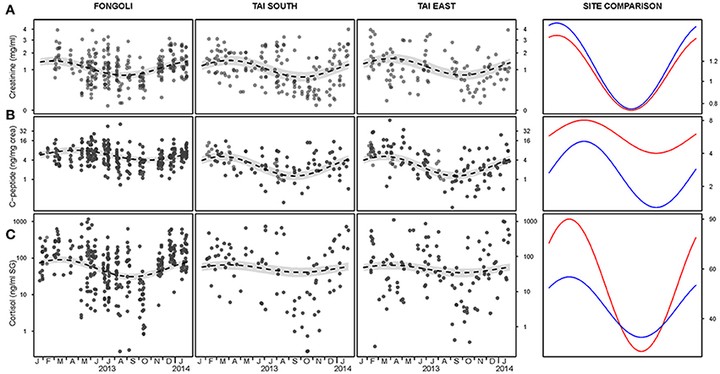Seasonal Variation in Physiology Challenges the Notion of Chimpanzees (Pan troglodytes verus) as a Forest-Adapted Species
 Figure 3. Adjusted and unadjusted seasonal variation of creatinine (A), c-peptide (B), and cortisol (C) levels at three chimpanzee communities. Fongoli is displayed in red and Taï in blue in the adjusted seasonal comparison (right column). All y-axes are displayed on a log scale except for creatinine (A) which is displayed on the square-root scale; confidence intervals are displayed in gray.
Figure 3. Adjusted and unadjusted seasonal variation of creatinine (A), c-peptide (B), and cortisol (C) levels at three chimpanzee communities. Fongoli is displayed in red and Taï in blue in the adjusted seasonal comparison (right column). All y-axes are displayed on a log scale except for creatinine (A) which is displayed on the square-root scale; confidence intervals are displayed in gray.Abstract
Savanna-mosaic habitats are thought to represent exceptional circumstances for chimpanzees (Pan troglodytes), and owing to the virtues of their habitat as well as peripheral biogeographic location, they are often regarded as marginal to the chimpanzee ecological niche. If these habitats are marginal, then we should expect that chimpanzees living in these habitats demonstrate physiological consequences of the extremity of this environment. We therefore compared seasonal variation in physiological responses to climatic and ecological factors in chimpanzees inhabiting Fongoli, a savanna-mosaic habitat at the margins of the chimpanzee range with chimpanzees from Taï National Park, a lowland rainforest centrally located within the West African chimpanzee subspecies (P. troglodytes verus) range. We accomplished this using urinary biomarkers of hydration (creatinine), energetic status (c-peptide), and stress (cortisol) collected simultaneously from research stations at each location. We found that Fongoli was both more extreme and seasonal in climatic measures like temperature and rainfall, although food availability was more variable at Taï than at Fongoli. Although living in an extreme and seasonally more variable environment, Fongoli chimpanzees were more stable in their c-peptide values than Taï chimpanzees, but showed more extreme variation in their cortisol values. Although chimpanzees at both sites demonstrated significant seasonal effects of dehydration (creatinine), the more extreme environmental variation at Fongoli promoted higher physiological seasonal costs in the form of elevated cortisol levels. Overall, these results supported the assertion that Fongoli as a savanna-mosaic habitat is more extreme in its climate and ecology than a forested site. It appears that extreme savanna-mosaic habitats represent a limit to the chimpanzee ecological niche with regard to thermoregulation, in that seasonal environmental conditions, namely the hot and dry conditions of the dry season, strain an individual’s ability to maintain homeostasis. However, Taï chimpanzees also faced dehydration as a limitation, which highlights that chimpanzees may experience certain challenges ubiquitously across their range, while other challenges remain habitat-specific. Hence, categorizing savanna habitats as universally more severe and challenging to chimpanzees than more heavily forested habitats does not yet appear to be warranted.